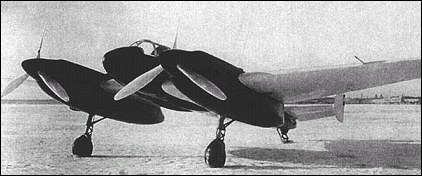|
| In 1938, the UV-VS (Upravlenie Voenno-vozdushnikh Sil - Administration of the Air Force) formulated a requirement for a two-seat multi-role high-speed combat aircraft. To meet this demand, the OKB (Experimental Construction Bureau) headed by Aleksandr S Yakovlev evolved the Ya-22, or Samolet 22. An aerodynamically clean, low-wing cantilever monoplane of mixed construction and powered by two 960hp M-103A (V Ya Klimov-developed two-speed supercharged derivative of the Hispano-Suiza 12Y) 12-cylinder Vee-type engines, the Ya-22 was proposed in three dedicated versions: long-range escort fighter, short-range bomber and tactical reconnaissance aircraft. Prototypes of all three variants were built simultaneously, the first to fly being the fighter, which, assigned the NKAP (State Commissariat for Aviation Industry) designation I-29, entered flight test in February 1939. This was closely followed by the BB-22 bomber and R-12 reconnaissance prototypes. These differed from the I-29 primarily in that the fuel tank immediately aft of the cockpit was supplanted by a bay accommodating either eight 50kg bombs in the BB-22 or photo-flashes (for use in conjunction with a single AFA-13 camera) in the R-12. The I-29 had twin 20mm ShVAK cannon in fairings beneath the forward fuselage and a single 7.62mm ShKAS for the aft-positioned observer/navigator, deployment of this gun being permitted by lowering of the aft-fuselage top decking. On 15 March 1939, shortly after commencement of flight testing, Yosif Stalin personally decided to order production of the bomber variant (as the M-105-powered Yak-2) to the exclusion of both fighter and reconnaissance versions.
 | A three-view drawing (1655 x 1310) |
| WEIGHTS |
| Take-off weight | 5023 kg | 11074 lb |
| Empty weight | 3796 kg | 8369 lb |
| DIMENSIONS |
| Wingspan | 14.00 m | 46 ft 11 in |
| Length | 10.18 m | 33 ft 5 in |
| Height | 3.30 m | 11 ft 10 in |
| Wing area | 29.40 m2 | 316.46 sq ft |
| PERFORMANCE |
| Max. speed | 567 km/h | 352 mph |
| Range | 1050 km | 652 miles |
| John, e-mail, 04.03.2024 20:37 Hey! I was wondering what sources you used when refferencing the build details of the Ya-22 fighter varient the I-29. Im carrying through a research project and would love any help. Thank you! reply |
|
Do you have any comments?
|
| 
COMPANY
PROFILE
All the World's Rotorcraft
|








UWU
reply